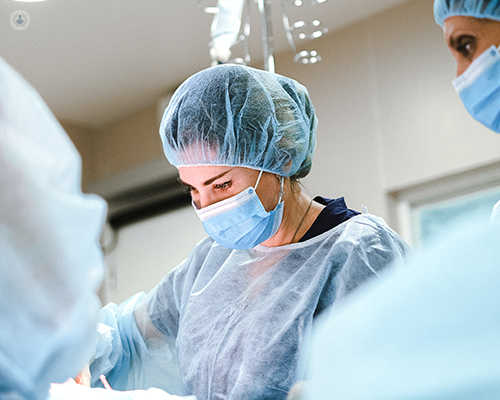How to know if your hip replacement needs revising and what to expect from revision surgery
Escrito por:Mr Amol Chitre, a UK leading orthopaedic surgeon, explains how you can identify the need for revision hip surgery and what to expect from it.
Not expecting to have revision hip surgery yet? See Mr Chitre’s article “10 reasons for early hip replacement revision surgery”.

How would you know if you need a hip revision?
In some cases, it will be immediately apparent that there is a problem with the hip replacement. For example, a hip that repeatedly dislocates is highly likely to need revision surgery. A fracture around the hip is equally likely to require surgery. A significant leg length issue will also be apparent early on after surgery.
Longer term, the most common complaint will be pain. This may be felt in either the groin area or the upper thigh/buttock. If the hip is coming loose, it can at first be identified by pain. This is pain on first moving, usually the first couple of steps after a period of rest. It occurs as the components of the hip move until they find a more stable position when the pain can settle. Infection can also present as pain and most surgeons will check for this problem thoroughly before embarking on revision surgery. Thigh pain may be a sign that the bone is reacting to the metal near it or in some cases that there is an impending fracture.
In some instances, there will be no apparent symptoms but significant problems within the hip replacement. For example, the hip may begin to wear out or start to come loose without any problems being evident. This is more of an issue with “metal-on-metal” hips when there can be some fairly significant problems with minimal initial symptoms. It is for this reason that the British Hip Society recommends that standard hip replacements are monitored seven years after the initial operation and every three years after. “Metal on metal” hip replacements should be monitored much more frequently, usually every year.
What does hip revision surgery involve?
Revision hip operations are much more variable than a standard hip replacement and the exact nature of the surgery will depend on the reason that revision surgery is required. If the reason for revision surgery is an infection, it may be necessary to perform the revision surgery in two separate operations: one to take out all the implants that have originally been put in, followed by a period of monitoring and antibiotics to make sure the infection is fully cleared before implanting the new hip.
Surgery will be planned to address the problem that demands the revision. For example,
- A dislocating hip may need to have the orientation of the components changed or special components placed to prevent dislocation.
- A revision for a fracture will require that the bone is fixed and stabilised before the hip is revised.
How successful is revision surgery?
Success will mainly depend on the reason for the revision surgery. Some problems, such as non-infected loosening, may be more readily amenable to revision surgery than others such as revision for a severe leg length issue. The chances of success are good if there is a particular, identified problem that needs to be corrected. The results are much less predictable if a cause for the pain has not been found pre-operatively.
What can cause your hip prosthesis to come loose?
Most commonly, hip replacements come loose due to the micromotion in the interface (tiny microscopic movements) between the bone and the implant. Over a long period, this will cause more and more movement and will have typical appearances of a loose hip on an X-ray. If there is an infection within the hip, this may also cause the components of the hip replacement to come loose.
What would happen if you didn't have revision surgery?
In certain situations, there is very little option but to have a revision procedure e.g. if there is a fracture around the hip replacement. However, problems can be spotted before they become too severe in most instances . The optimal timing of any planned revision surgery and whether it can be postponed is extremely variable and should be discussed on an individual basis with your surgeon.
If not addressed, however, the problems necessitating revision surgery may become worse and cause more significant problems. For example, repeated dislocations will require multiple hospital admissions to reduce the hip, an infection within the hip may progress to sepsis and a loose hip may cause the bone to thin out and fracture.
How many times can a hip be revised?
There is no limit to the number of times a hip replacement can be redone, but the outcome and options available will depend on the amount and quality of the bone left to support any new components that need to be implanted. In certain instances, a revision hip replacement may even be easier to recover from than a primary hip replacement, whilst on some occasions, it may not be possible to safely implant new components.
What is recovery like?
Recovery is much harder to generalise and will depend significantly on what needs to be done at revision surgery. A “simple” revision where only one component is changed and the underlying bone quality is good may not need a different recovery to the initial hip replacement. However, if a more complicated reconstruction of either bone or soft tissue is required, your surgeon may alter your rehabilitation protocol to allow for a more gradual recovery which puts less stress on recovering and healing tissue.
Discover how Mr Chitre’s expertise on hip replacement and revision surgery can help you – visit his profile.


